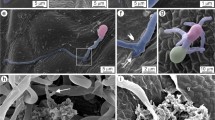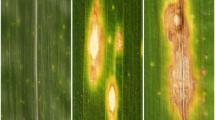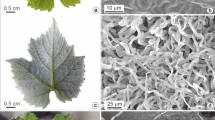Abstract
To clarify the histopathological characteristics of Camellia oleifera that were infected by Colletotrichum fructicola, this study utilized frozen tissue sections, whole-stain clearing and transmission electron microscopy to observe the time of transformation from biotrophic to necrotrophic when Co. fructicola infects leaves, as well as the colonization and expansion of the pathogenic fungus at different stages on the leaves. The Co. fructicola conidia produced germ tubes 2 h post-inoculation, and appressoria began to form 4 h after inoculation. There were two ways that pathogens can use to invade the leaves of Ca. oleifera. One was to directly penetrate the host cuticle, while the other involved invasion from the stomata of the host using germ tubes or hyphae. A few infection vesicles could then be observed in the leaf tissue, and the infection vesicles produce thicker septal primary hyphae after 24 h of infection. When the infection reached the 40 h point, the fungus started to produce secondary hyphae with smaller diameter than that of the primary hyphae and gradually expanded into the adjacent cells. Transmission electron microscopy revealed that when the secondary hyphae entered the mesophyll cells, the contents in the cells were digested and a cavity gradually formed, indicating that the cells had been killed. Thus, the appearance of the secondary hyphae marked the point at which Co. fructicola entered into a destructive necrotrophic stage.






Similar content being viewed by others
References
Bai JK (2016) Interaction between resistant and susceptible apple cultivars and colletotrchum fructicola. Dissertation, Northwest A&F University
Chen XM, Wang J, Sun S, Wu HX (2009) Histopathological observation on the invasion of Colletotrichum gloeosporioides to oil tea. For Pest Dis 28(05):6–8. https://doi.org/10.3969/j.issn.1671-0886.2009.05.002
Chen SC, Tian ZJ, Chen DC (1964) Studies on the perithecial stage of the anthracnose fungus on Camelliae Oleosa (lour.) reh. Acta Phytopathol Sin (01): 45–52. https://doi.org/10.13926/j.cnki.apps.1964.01.005
Fu DD, Wang W, Qin RF, Zhang R (2014) Colletotrichum fructicola, first record of bitter rot of apple in China. Mycotaxon 126(1):23–30. https://doi.org/10.5248/126.23
Jin AX, Zhou GY, Li H (2009) Progress, problem and prospect of oil camelliae anthrancnose (Colletotrichum gloeosporioides) research. Forest Pest Dis 28(02):27–31
Jin Q (2017) The Research on Cytology of the infection of oil tea by Colletotrichum gloeosporioedes and physiological response. Dissertation, Central South University of Forestry and Technology
Jiang JJ, Zhai HY, Li HN, Wang ZH, Chen YS, Hong N, Wang GP, Chofong GN, Xu WX (2014) Identification and characterization of Colletotrichum fructicola causing black spots on young fruits related to bitter rot of pear (Pyrus bretschneideri Rehd.) in China. Crop Prot 58:41–48. https://doi.org/10.1016/j.cropro.2014.01.003
Latunde-Dada AO (2001) Colletotrichum: tales of forcible entry, stealth, transient confinement and breakout. Mol Plant Pathol 2(4):187–198. https://doi.org/10.1046/j.1464-6722.2001.00069.x
Latunde-Dada AO, O’Connell RJ, Nash C, Pring RJ, Lucas JA, Bailey JA (1996) Infection process and identity of the hemibiotrophic anthracnose fungus (Colletotrichum destructivum) from cowpea (Vigna unguiculata). Mycol Res 100(9):1133–1141. https://doi.org/10.1016/S0953-7562(96)80226-7
Li H (2018) Population Genetic Analyses of Fungal Pathogen Colletotrichum on Tea-Oil Tree in China and Characterization of a MAPK gene CfPMK1 in the Pathogen. Dissertation, Central South University of Forestry and Technology
Li H, Zhou GY, Liu JA, Xu JP (2016) Population genetic analyses of the fungal pathogen Colletotrichum fructicola on tea-oil trees in China. PLoS ONE 11(6):e0156841. https://doi.org/10.1371/journal.pone.0156841
Li H, Zhou GY, Xu JP, Zhu DX (2014) Pathogen identification of a new anthracnose of Camellia oleifera in China based on multiple-gene phylogeny. Plant Prot 41(5):602–607. https://doi.org/10.13802/j.cnki.zwbhxb.2014.05.034
Leandro LFS, Gleason ML, Nutter FW, Wegulo SN, Dixon PM (2001) Germination and sporulation of Colletotrichum acutatum on symptomless strawberry leaves. Phytopathology 91(7):659–664. https://doi.org/10.1094/phyto.2001.91.7.659
Leandro LFS, Gleason ML, Nutter FW, Wegulo SN, Dixon PM (2003) Influence of temperature and wetness duration on conidia and appressoria of Colletotrichum acutatum on symptomless strawberry leaves. Phytopathology 93(4):513–520. https://doi.org/10.1094/phyto.2003.93.4.513
Liu W (2012) Studies on etiology, occurrence and control of Camelli Oleifera anthracnose. Dissertation, Huazhong Agricultural University
Mao FH, Wang HF, Zhou ML (2010) Functional properties of Camellia oleifera seed oil. Food Sci Technol 35(1):181–185. https://doi.org/10.13684/j.cnki.spkj.2010.01.049
Ma XH (2013) Research status and application prospect of the seed oil of Camellia oleifera. J Green Sci Technol 12:116–117. https://doi.org/10.3969/j.issn.1674-9944.2013.12.047
Pain NA, Green JR, Jones GL, O’Connell RJ (1996) Composition and organisation of extracellular matrices around germ tubes and appressoria of Colletotrichum lindemuthianum. Protoplasma 190(3–4):119–130. https://doi.org/10.1007/BF01281311
Perfect SE, Hughes HB, O’Connell RJ, Green JR (1999) Colletotrichum: a model genus for studies on pathology and fungal–plant interactions. Fungal Genet Biol 27(2–3):186–198. https://doi.org/10.1006/fgbi.1999.1143
Slade SJ, Harris RF, Smith CS, Andrews JH (1987) Microcycle conidiation and spore-carrying capacity of Colletotrichum gloeosporioides on solid media. Appl Environ Microbiol 53(9):2106–2110. https://doi.org/10.1128/AEM.53.9.2106-2110.1987
Sharma G, Shenoy BD (2014) Colletotrichum fructicola and C. siamense are involved in chilli anthracnose in India. Arch Phytopathol Plant Protect 47(10):1179–1194. https://doi.org/10.1080/03235408.2013.833749
Shang SP, Liang XF, Liu GL, Zhang S, Lu ZX, Zhang R, Gleason ML, Sun GY (2020) Histological and ultrastructural characterization of the leaf infection events of Colletotrichum fructicola on Malus domestica ‘Gala.’ Plant Pathol 69(3):538–548. https://doi.org/10.1111/ppa.13141
Shen YF (2015) Relationship between morphology, anatomy structure characteristics, physiological characteristics and Colletotrichum gloeosporioides of Camellia oleifera fruit. Dissertation, Anhui Agricultural University
Velho AC, Rockenbach MF, Mondino P, Stadnika MJ (2016) Modulation of oxidative responses by a virulent isolate of Colletotrichum fructicola in apple leaves. Fungal Biol 120(10):1184–1193. https://doi.org/10.1016/j.funbio.2016.07.001
Yang GD (2009) Resistance mechanism of Camellia oleifera cultivars to Colletotrichum gloeosporioides. Dissertation, Anhui Agricultural University
Yuan SL, Zhang NT, Weng YX, Hua SL, Liu HZ, Meng MQ (1963) Research on Camellia anthracnose. J Plant Protect 03:253–262
Zhang P, Li CY, Zhao QQ, Wang LH, Ma L (2020) Inhibition effects of biocontrol bacteria strains on the pathogen of Camellia oleifera anthracnose. J Beijing for Univ 42(10):107–116
Acknowledgements
The authors would like to thank all the reviewers who participated in the review.
This study was supported by National Natural Science Foundation of China (31971661), Graduate education innovation project and professional ability improvement project of Hunan Province (CX20200744) and Scientific Innovation Fund for Postgraduates of Central South University of Forestry and Technology (CX20202005).
Author information
Authors and Affiliations
Corresponding author
Rights and permissions
About this article
Cite this article
Li, M., Liu, J. & Zhou, G. Histopathological and ultrastructural observations of Camellia oleifera infected with Colletotrichum fructicola. Australasian Plant Pathol. 50, 523–531 (2021). https://doi.org/10.1007/s13313-021-00811-2
Received:
Accepted:
Published:
Issue Date:
DOI: https://doi.org/10.1007/s13313-021-00811-2




